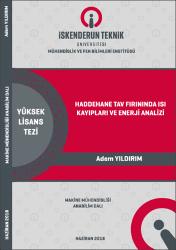| dc.contributor.advisor | Koç, Yıldız | |
| dc.contributor.author | Yıldırım, Adem | |
| dc.date.accessioned | 2019-07-11T20:02:29Z | |
| dc.date.available | 2019-07-11T20:02:29Z | |
| dc.date.issued | 2018 | en_US |
| dc.date.submitted | 2018 | |
| dc.identifier.citation | Yıldırım, A. (2018). Haddehane tav fırınında ısı kayıpları ve enerji analizi (Yüksek Lisans Tezi). İskenderun Teknik Üniversitesi / Mühendislik ve Fen Bilimleri Enstitüsü, Hatay. | en_US |
| dc.identifier.uri | https://hdl.handle.net/20.500.12508/422 | |
| dc.description.abstract | Günümüzde enerji tüketimi her ne kadar gelişmişliğin bir ölçüsü olarak kabul edilmeye başlanmış ise de sınırlı enerji kaynakları ve çevresel nedenlerden ötürü ülkeler enerji tüketimlerini hızla kontrol altına almaya çalışmaktadır. Bu nedenle özellikle demir ve çelik sektörü gibi yüksek enerji tüketen sektörlerde enerji yönetimi konusuna giderek artan bir talep söz konusudur. Enerji yönetiminin temeli, tesise giren enerji ve bu enerjinin kullanım alanları ve atılan miktarlarının tespitine dayanmaktadır. Sınırlı enerji kaynakları ve çevresel faktörleri göz önünde bulundurularak bu çalışma kapsamında yüksek enerji tüketimine sahip sektörlerden birisi olan demir ve çelik sektöründe çalışan bir tesisteki tav fırınının analizi yapılmıştır. Enerji dengesi temeline dayandırılarak yapılan çalışmada, fırına giren enerjilerin yanı sıra fırının duvarlarından, egzoz gazından ve soğutma sisteminden atılan ısı miktarları hesaplanmıştır. Elde edilen veriler ve hesaplamalar göz önünde bulundurularak tav fırınının enerji tüketiminin azaltılması ya da giren enerjinin daha verimli kullanılması için alternatif yöntemler önerilmiştir. Çalışma sonucunda İskenderun bölgesinde faaliyet göstermekte olan bir haddehanenin tav fırınının, ısı kayıpları incelenmiş ve enerji analizi yapılmıştır. Termodinamiğin birinci yasası göz önünde bulundurularak tav fırınına giren ve çıkan enerji miktarları tespit edilmiştir. Bu hesaplamalar neticesinde, tav fırınına ısı kaynağı olarak giren doğalgazın enerjisinin giren toplam enerji içerisindeki payının %91,63, giren yanma havasının giren toplam enerji içerisindeki payının %6,94 ve soğuk kütüğün absorbe ettiği enerjinin giren toplam enerji içerisindeki payının %1.44 olduğu görülmüştür. Çıkan toplam enerji içerisinde; sıcak kütüğün absorbe ettiği enerji %60,69, duvar yüzeyinden kaybedilen enerji %7,76, enfiltrasyon ile kaybolan enerji %0,81, baca gazı ile atılan enerji %28,54 ve göz ardı edilen küçük ısı kayıplarının toplamının %2,2 paya sahip olduğu hesaplanmıştır. Bu değerlerin sonucunda, tav fırınının ısıl verimi %60,12 olarak bulunmuştur. Bu hesaplamalar göz önünde bulundurularak ayrıca sistem performansını arttırıcı yöntemler araştırılarak çalışma kapsamında tartışılmıştır. | en_US |
| dc.description.abstract | Today, although energy consumption has started to be considered as a measure of development, countries are trying to quickly control energy consumption due to limited energy resources and environmental reasons. For this reason, there is an increasing demand for energy management especially in high energy consuming sectors such as the iron and steel sector. The foundation of energy management is based on the determination of the energy entering the facility and the areas of use and the amount of energy thrown. Considering limited energy resources and environmental factors, an analysis of a furnace operating in the iron and steel sector, one of the sectors with high energy consumption, was carried out. In the study on the basis of the energy balance basis, the energy entering into the furnace as well as the walls of the furnace, the amount of heat discharged from the exhaust gas and cooling system are calculated. The resulting data and calculations to reduce energy consumption by taking into account the reheat furnace or into energy has been proposed for more efficient use of alternative methods. As a result of the study, the heat losses of the reheat furnace in the rolling mill operating in the Iskenderun region were investigated and analyzed of energy. Taking into account the first law of thermodynamics, the amount of energy entering and exiting the reheat furnace was determined. As a result of these calculations, the energy of natural gas is 91,63%, the energy of the air is 6,94%, the energy of absorbed the cold billet is 1,44%, the energy of absorbed the hot billet was 60,69%, the wall surface losses 7,76%, the infiltration losses 0,81%, the flue gas energy loss 28,54% and the other can not be calculated losses 2,2%. As a result of these values, the reheat furnace's thermal efficiency was 60,12%. Considering these calculations, the system performance improvement methods were investigated and discussed within the scope of the study. | en_US |
| dc.language.iso | tur | en_US |
| dc.publisher | İskenderun Teknik Üniversitesi / Mühendislik ve Fen Bilimleri Enstitüsü / Makine Mühendisliği Anabilim Dalı | en_US |
| dc.rights | info:eu-repo/semantics/openAccess | en_US |
| dc.subject | Haddehane | en_US |
| dc.subject | Tav fırını | en_US |
| dc.subject | Enerji dengesi | en_US |
| dc.subject | Isıl verim | en_US |
| dc.subject | Rolling mill | en_US |
| dc.subject | Reheat furnace | en_US |
| dc.subject | Energy balance | en_US |
| dc.subject | Thermal efficiency | en_US |
| dc.title | Haddehane tav fırınında ısı kayıpları ve enerji analizi | en_US |
| dc.title.alternative | Heat losses and energy analysis of reheating furnaces in rolling mill | en_US |
| dc.type | masterThesis | en_US |
| dc.contributor.department | Mühendislik ve Fen Bilimleri Enstitüsü | en_US |
| dc.relation.publicationcategory | Tez | en_US |
| dc.contributor.isteauthor | Koç, Yıldız | |
| dc.relation.index | İndeks Bilgisi Yok | en_US |
















